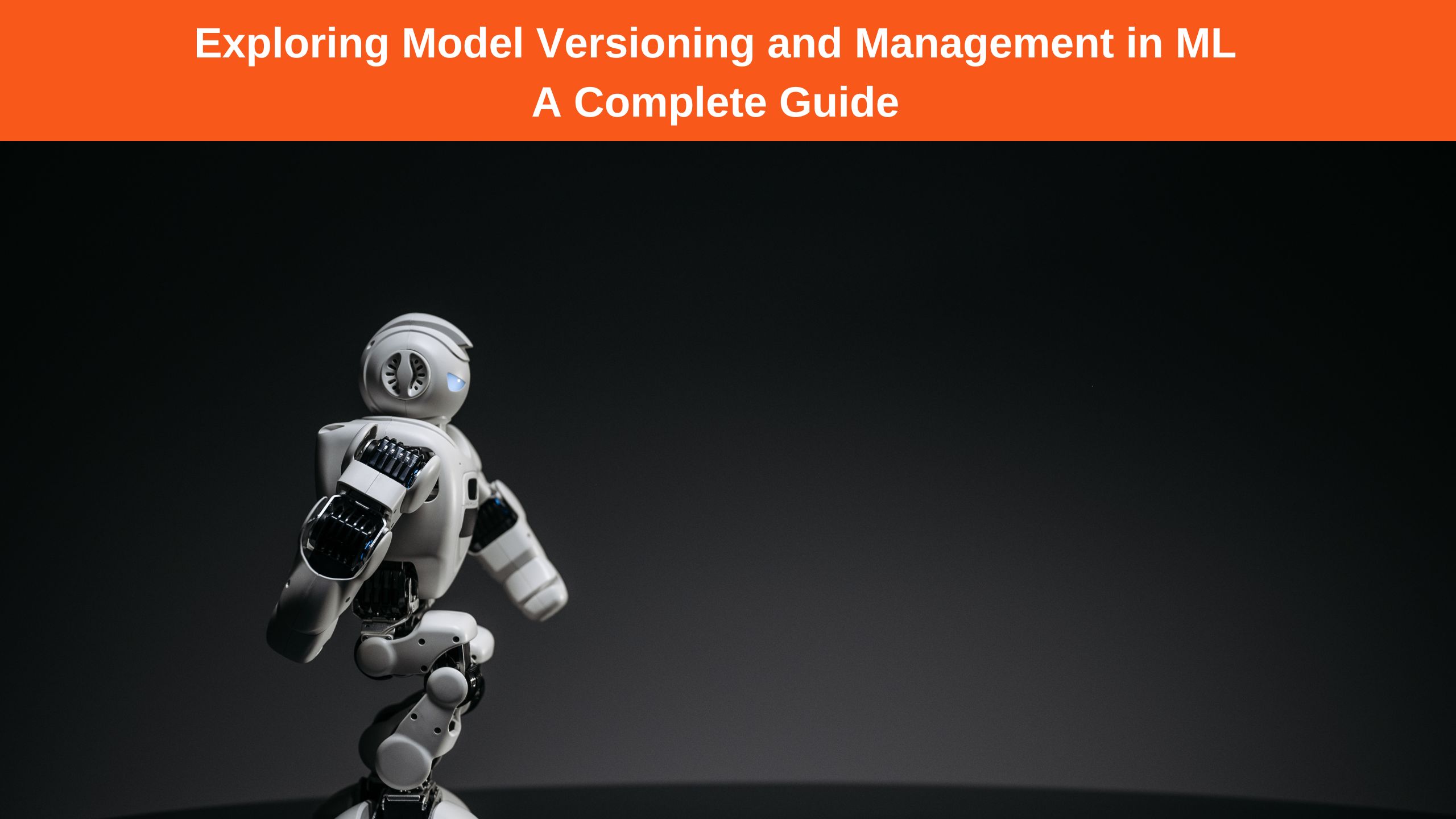Exploring Model Versioning and Management in ML - A Complete Guide

Strong 8k brings an ultra-HD IPTV experience to your living room and your pocket.
Model versioning and management are essential aspects of the machine learning (ML) lifecycle, facilitating the organization, tracking, and maintenance of ML models across various stages of development and deployment. In the dynamic field of data science, where models are constantly iterated upon and refined, effective versioning practices are crucial for maintaining reproducibility, collaboration, and reliability. Model versioning involves systematically labeling and storing different iterations of ML models along with their associated metadata and dependencies. This allows data scientists and ML engineers to trace the evolution of models, compare performance across versions, and revert to previous iterations if necessary. Additionally, model management encompasses broader processes such as model registration, deployment, monitoring, and retirement, ensuring that ML models are effectively utilized and maintained throughout their lifecycle. As organizations increasingly rely on ML models to drive business decisions and innovation, implementing robust model versioning and management practices becomes imperative. This introduction sets the stage for exploring the various techniques, challenges, tools, and future trends in model versioning and management, highlighting their significance in optimizing ML workflows and fostering success in data-driven endeavors.
Importance of Model Versioning
Model versioning plays a crucial role in machine learning (ML) development by providing a systematic approach to managing changes and iterations in ML models. One key aspect of model versioning is maintaining a clear record of model changes, which helps teams track the evolution of models over time. By labeling and documenting each version, data scientists can easily identify which changes were made, when they were implemented, and by whom. This transparency is essential for ensuring reproducibility and facilitating collaboration among team members.
Moreover, model versioning enables effective model comparison. Data scientists can assess the performance of different model versions against various metrics to identify improvements or regressions. This process helps teams make informed decisions about which model version to deploy in production or further iterate upon. Additionally, versioning allows for the easy rollback to previous versions in case of issues or unexpected results with newer iterations, providing a safety net during the development process.
Challenges in Model Versioning
Despite its importance, model versioning poses several challenges that organizations must address. One significant challenge is managing dependencies and environments across different model versions. ML models often rely on specific libraries, frameworks, or data preprocessing steps, and changes in these dependencies can impact model behavior. Ensuring consistency in environments across versions is essential for reproducibility and preventing unexpected behavior when deploying models.
Another challenge is scalability, especially for large-scale ML projects with numerous models and frequent updates. As the number of models and iterations increases, managing version control manually becomes cumbersome and error-prone. Organizations need robust version control systems and automation tools to handle versioning efficiently and scale with their ML projects.
Furthermore, collaboration and communication among team members can be challenging, especially in distributed or remote teams. Ensuring that everyone has access to the latest versions of models, understanding changes made by others, and providing feedback or suggestions require effective collaboration tools and processes.
Addressing these challenges requires a combination of technical solutions, such as version control systems and automation tools, and organizational practices that promote transparency, communication, and collaboration among team members.
Strategies for Effective Model Versioning
To overcome the challenges associated with model versioning, organizations can adopt several strategies:
1. Use Version Control Systems: Implementing robust version control systems, such as Git or Mercurial, can effectively manage changes to ML models and track their evolution over time. Version control systems allow data scientists to create branches for different experiments, merge changes, and revert to previous versions when needed.
2. Automate Versioning Processes: Leveraging automation tools and scripts can streamline the model versioning process. Automation helps ensure consistency in versioning practices across different models and reduces the risk of human error. Continuous integration and continuous deployment (CI/CD) pipelines can automate the testing and deployment of model versions, enabling faster iteration cycles.
3. Adopt Model Registry Platforms: Model registry platforms provide centralized repositories for storing and managing ML models, along with their metadata, dependencies, and associated artifacts. These platforms offer versioning capabilities, model lineage tracking, and access control mechanisms, facilitating collaboration and reproducibility across teams.
4. Implement Documentation Standards: Establishing documentation standards for ML models is essential for capturing relevant information about each version, including changes, performance metrics, experimental conditions, and dependencies. Comprehensive documentation enables data scientists to understand the context and rationale behind model changes, facilitating collaboration and knowledge sharing.
Best Practices for Model Management
In addition to effective versioning strategies, implementing best practices for model management is crucial for ensuring the success of ML projects:
1. Establish Governance Policies: Define governance policies and guidelines for model development, versioning, and deployment. Establish clear roles and responsibilities within the organization, and enforce standards for model documentation, testing, and validation.
2. Monitor Model Performance: Continuously monitor the performance of deployed models in production environments. Use metrics and monitoring tools to track model behavior, detect anomalies, and assess model drift. Regularly update models based on performance feedback and changing business requirements.
3. Ensure Reproducibility: Maintain reproducibility by capturing all relevant information, including code, data, and environment configurations, for each model version. Use containerization technologies like Docker to package models along with their dependencies, ensuring consistent execution across different environments.
4. Facilitate Collaboration: Foster collaboration and knowledge sharing among data science teams by implementing collaborative tools and practices. Encourage peer code reviews, pair programming, and knowledge sharing sessions to exchange ideas, troubleshoot issues, and improve model quality.
By adopting these strategies and best practices, organizations can effectively manage the versioning and deployment of ML models, enabling efficient collaboration, reproducibility, and scalability in their machine learning initiatives.
Deployment and Scaling Considerations
When deploying machine learning models, several considerations must be taken into account to ensure scalability, reliability, and cost-effectiveness:
1. Infrastructure Scalability: Choose a deployment infrastructure that can scale dynamically to accommodate varying workloads and user demand. Cloud-based platforms like Amazon Web Services (AWS), Google Cloud Platform (GCP), and Microsoft Azure offer scalable compute resources and managed services for deploying and serving ML models.
2. Containerization: Containerization technologies like Docker and container orchestration platforms like Kubernetes provide scalable and portable environments for deploying and managing ML models. Containers encapsulate models and their dependencies, ensuring consistent deployment across different environments and facilitating scalability and resource utilization.
3. Serverless Architectures: Serverless computing platforms, such as AWS Lambda and Azure Functions, abstract away infrastructure management and automatically scale compute resources based on demand. Serverless architectures are well-suited for lightweight, event-driven ML applications and can help reduce operational overhead and costs.
4. Auto-scaling: Implement auto-scaling mechanisms to dynamically adjust compute resources based on workload demands. Auto-scaling policies can be configured to scale up or down compute instances based on metrics like CPU utilization, request throughput, or queue length, ensuring optimal performance and cost efficiency.
Monitoring and Maintenance
Monitoring and maintenance are essential components of effective model management and deployment:
1. Performance Monitoring: Continuously monitor the performance of deployed models in production environments. Track key performance indicators (KPIs) such as prediction accuracy, latency, throughput, and error rates. Implement monitoring dashboards and alerts to detect anomalies and performance degradation.
2. Health Checks and Logging: Implement health checks and logging mechanisms to ensure the availability and reliability of deployed models. Perform regular health checks to verify model responsiveness and correctness. Log model predictions, errors, and system events for troubleshooting and auditing purposes.
3. Security and Compliance: Implement robust security measures to protect deployed models and data from unauthorized access, tampering, or breaches. Use encryption, access controls, and authentication mechanisms to safeguard sensitive information. Ensure compliance with regulatory requirements, such as GDPR, HIPAA, or industry-specific standards.
4. Regular Updates and Maintenance: Regularly update and maintain deployed models to address bugs, vulnerabilities, and changing business requirements. Establish procedures for version control, model retraining, and deployment automation. Schedule regular maintenance tasks, such as patching, data updates, and performance tuning, to keep models running smoothly.
By prioritizing monitoring and maintenance activities and leveraging scalable deployment architectures, organizations can ensure the reliable and efficient operation of their machine learning models in production environments.
Conclusion
In conclusion, effective model versioning, deployment, and management are crucial for the success of machine learning applications in production. By adopting scalable deployment architectures, such as containerization and serverless computing, organizations can ensure flexibility, scalability, and cost-effectiveness in deploying and serving ML models. Furthermore, robust monitoring, maintenance, and security practices are essential to maintain model performance, reliability, and compliance with regulatory standards. With proper attention to these considerations, businesses can maximize the value derived from their machine learning investments while minimizing operational risks. For professionals seeking to enhance their skills in machine learning deployment and management, enrolling in a comprehensive Data Science Training Program in Noida, kochi, goa, bangalore, ludhiana, etc, can provide the necessary knowledge and hands-on experience to excel in this rapidly evolving field.
Note: IndiBlogHub features both user-submitted and editorial content. We do not verify third-party contributions. Read our Disclaimer and Privacy Policyfor details.


